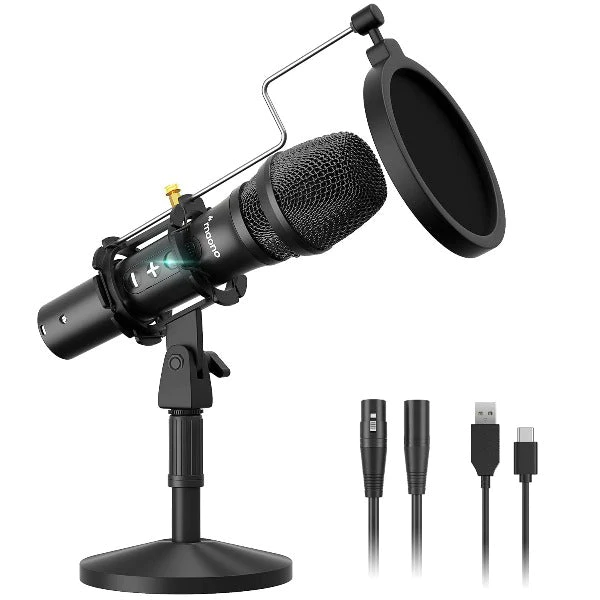Maono might just be my favourite “entry-level” sound equipment manufacturer. The previous Maono product that I tested, the Maonocaster E2 A sound production studio, is an excellent piece of kit that looked and felt premium. It has an excellent range of features, and does its job with minimal fuss. I use it to this day for all my video production, and my YouTube channel is the better for it. The Maono HD300 Dynamic Microphone solidifies this company as the place to go to get your feed wet with sound production.
The main thing that you’re going to love about the HD300 is that for the ridiculously low price of $70, you’re getting a lot of versatility. It is powered both by USB and XLR inputs, meaning that you can hook this mic up to just about any device that supports mics and make use of it. Working from your home studio with the full production set-up? Plug in that XLR input and take full advantage of the pro standard. On the road and putting down a quick podcast or interview? Whip the mic out of the bag and plug it in via USB. There are far more expensive microphones that fail to include what should seem like a pretty logical feature.
And, as an added bonus, the microphone unit has a 3.5mm headphone jack built right into it. That’s perfect for, again, when you’re recording on the road and want some real-time feedback on what your eventual audience will hear. It’s no good when using the XLR input (with XLR being an analogue data transfer), but if you’re using XLR, chances are you’re in a static studio environment and have plenty of places to insert your headset anyway.
In terms of sound quality, the HD300 punches well above its weight, within a fairly narrow, but still worthwhile sound range. The device is tuned towards voice rather than other sounds, with a range of 17Hz to 40Hz, and as such does a decent job of blocking out background ambient noises and focusing the data capture on your voice. I’ve included two videos below, one I recorded with the HD300, and another with a high-end Rode microphone for comparison. You can tell there’s a difference, sure, but my voice is still coming through clearly via the HD300 (I think so, anyway), and, again, it must be emphasised that this is a vastly lower-cost option. It’s much more portable, too. I’ll never be trying to lug the Rode around in my backpack.
One of the few issues that I have with the HD300 as a recording device – and you will be able to hear this in the video – is that the mic doesn’t like it when I turn my head too far away from directly facing the device. The volume and timbre drops off quickly, and that’s not because I’m suddenly whispering. This is because the device uses cardioid polar pattern technology, meaning that it will only register sound from the front while ignoring anything that comes in from the sides and rear. This is a great technology for cancelling ambient noise (and, again, using it while out and about), but is also perhaps a little too aggressive here for a device where people will be expecting to take advantage of the portability of it. To put it another way, the direction of the voice isn’t such an issue if you’ve set the mic up on its stand or boom at home and have a static device to talk to, but if you’re on the road and holding it by hand (let along passing it back and forth between speakers), the natural human condition is not to stand perfectly still while talking, and the Maono really does ask for some pretty precise aiming.
There’s also the issue that the Maono HD300 isn’t great with plosive noises, though this again is only an issue if you’re using it on the go, as a simple pop-filter solves it when set up in the home.
(Commentary recorded on the Maono HD300)
(Commentary recorded with Rode Podmic)
Otherwise, the only real problem with the Maono HD300 is that it’s a little limited in its range of applications for serious use. You’re not going to want to record music on it, for example, and the slight muffling is just enough that you won’t want to use it for extended recording where your voice is the only sound asset. It’s not a tool for an aspiring audiobook narrator for example. However, for streamers, YouTubers, and people that are just starting out, this device makes a lot more sense than spending big from day one.
I’m going to continue to use the Maono HD300. It will be my microphone for events and other opportunities where I’ll have my laptop, but very little else. The sturdy design, combined with the way it so effectively mutes ambient noise, make it incredibly good value for $70. For those same reasons it’s also ideal as a backup mic, much like a professional photographer will always have a prosumer camera spare just in case the worst happens with their preferred piece of kit. The HD300 isn’t the perfect mic, but it is certainly near-on the perfect option for its price point.













I’ve never heard of this manufacturer. Unfortunately availability in my country is nihil.
Not even direct from the manufacturer? Tha’s such a pity: https://www.maono.com/products/usb-xlr-cardioid-dynamic-microphone-maono-hd300t